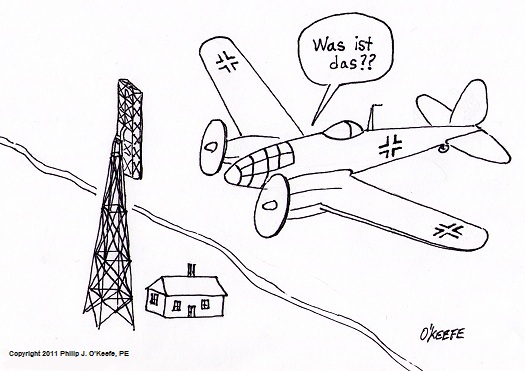| Pop some corn, defrost meat, quickly heat a frozen dinner. What modern day miracle is capable of doing all this and more? The microwave oven, of course. They’ve become an integral part of modern kitchens and our lifestyle. Did you ever wonder how they came to be? We’ll have to turn back the hands of time over 70 years to the dark days of World War II to find out.
WWII began when Adolph Hitler’s Nazi regime conspired with Joseph Stalin’s Soviet Russia to invade Poland in September, 1939. From there, German forces went on to sweep across much of continental Europe, and even as far as North Africa and the Middle East. In the face of these and future war maneuvers, Great Britain remained our ally and a significant force to be dealt with. Although Hitler was intent on bringing the British Empire to it knees by means of aerial bombardment, he did not succeed. He failed to take into account the fact that the British Royal Air Force Fighter Command had a unique advantage over his German Luftwaffe– or Air Force to those of you not up on your German. The advantage was called RADAR, an acronym for RAdio Detection And Ranging. Thanks to this proprietary technology, the British Fighter Command was able to detect incoming German warplanes well in advance of their arrival over British soil, and this provided British pilots with enough time to scramble their fighter planes and get a jump on their attackers. Although horribly outnumbered, the Royal Air Force planes managed to inflict heavy casualties on the Luftwaffe. In fact, this Battle of Britain, as it came to be known, marked the first defeat of Hitler’s military forces during the war. So how does this modern marvel of RADAR work? Simply stated, it transmits radio waves from an antenna. When these waves strike an object, say an approaching German airplane, some waves are reflected back to a special receiver antenna. The reflected radio waves are then converted by the radar system into a “blip” on a viewing screen. A radar operator stands at the ready, trained in the art of interpreting radar blips. He or she is quickly able to assess the approaching object’s position, direction of travel, and speed of approach. Although the ideas that led to the development of radar had been around for some time before WWII, it wasn’t until the late 1930s that engineers began developing it for air defense purposes. They first developed what was called a long wave radar system, referring to the fact that the radio waves transmitted had a long wavelength, about 1.5 meters. The British, at the top of their game, had anticipated the Nazi threat and installed an array of these on their east coast by 1940. Although long wave radar worked well enough during the Battle of Britain, it required massive, land-based antennas to operate, which proved to be cumbersome. It also couldn’t give operators a good idea of how many planes were approaching. Then, just months before the beginning of the Battle of Britain, British researchers developed an ultra top secret device they dubbed a “resonant-cavity magnetron,” or magnetron for short. This magnetron was capable of producing short radio waves, in the range of 1 to 10 millimeters, and these came to be known as microwaves. The technology mastered in the magnetron opened the door to an improved radar system, one which became mobile. These systems were more easily installed on aircraft, ships, and land vehicles. Microwave radar was also found to be better at detecting small objects than its massive predecessor technology. Unfortunately, microwave radar couldn’t be put to use in time for the Battle of Britain, but it did play a pivotal role in the defeat of Axis, that is the opposing side’s, forces during the remainder of WWII. Next time we’ll take a closer look at the resonant cavity magnetron and find out how microwave radar led to the development of the famous oven that bears its name. _____________________________________________ |
Tags: engineering expert witness, forensic engineer, long wave radar, microwave cooking, microwave oven, microwave radar, microwaves, RADAR, radiation





I will never forget when my mum got her first microwave oven (“wave.”) It was late 1980 and the thing was huge, about 30″ across and deep. She actually took a microwave cooking class at the local community college. Chuckle. Then she decided she would make the entire traditional Thanksgiving dinner in the wave: turkey, stuffing, yams, etc. You can imagine how that turned out. An unevenly cooked turkey with no color, stuffing that was burned on the edge and raw in the middle, and the marshmallow yam topping stuck all over the inside of the wave. Ah, those were the days.